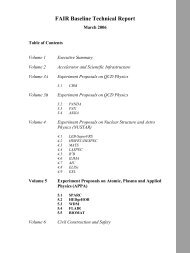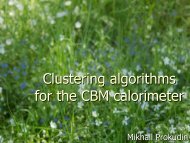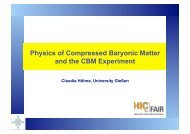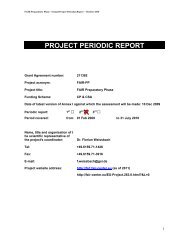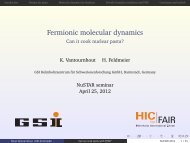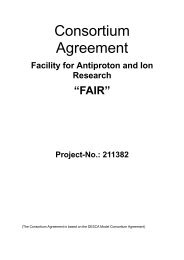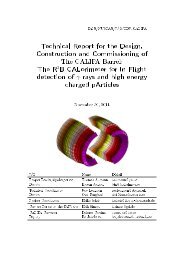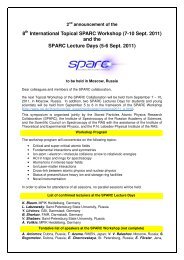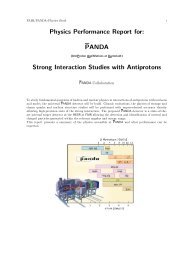NeuLAND - FAIR
NeuLAND - FAIR
NeuLAND - FAIR
Create successful ePaper yourself
Turn your PDF publications into a flip-book with our unique Google optimized e-Paper software.
events<br />
800<br />
600<br />
400<br />
200<br />
0<br />
0 200 400 600 800 1000<br />
total light (a.u.)<br />
events<br />
600<br />
400<br />
200<br />
0<br />
0 50 100 150<br />
multiplicity<br />
Figure 4.14.: Left hand side: Total energy deposited in <strong>NeuLAND</strong> from 600 MeV neutrons<br />
for multiplicities of 1 (black), 2 (green), 3 (red), 4 (blue), 5 (yellow)<br />
and 6 (magenta). Right hand side: Multiplicity from number of submodules<br />
with valid signals, again for 1 to 6 neutrons impinging with 600 MeV.<br />
4.5.3. Neutron Tracking<br />
For the final assignment of neutrons we now utilize the calorimetric information for<br />
the neutron multiplicity. Typically, the number of clusters in the event is much larger<br />
than the derived neutron multiplicity, as detailed before. We, therefore, have to select<br />
from the list of clusters the ones that are most reliable, thus ensuring that also the<br />
correct momenta of neutrons are reconstructed. The time-wise first cluster is taken as<br />
the first neutron track. For the remaining clusters, a resorting procedure is performed.<br />
An excellent criterion appears to be a combined requirement on the smallest difference<br />
of velocity of the neutron βcluster (associated with the cluster), the beam velocity βbeam<br />
and the largest energy deposit of the cluster Ecluster dep . The clusters are sorted according<br />
to their values of<br />
Rcluster = |βcluster − βbeam|<br />
E cluster<br />
dep<br />
(4.2)<br />
starting with the smallest value of Rcluster. Finally, clusters from this sorting are defined<br />
as neutron tracks up to the maximum number of neutrons from the calorimetry<br />
argument. The remaining clusters are eliminated from the further analysis.<br />
The quality of the neutron detection and its separation into the various multiplicities can<br />
be understood from the so-called neutron separation matrices, displayed in tables 4.5 for<br />
200, 600 and 1000 MeV neutrons impinging on <strong>NeuLAND</strong>, at a distance of 15.5 m to<br />
the origin of the neutrons. For multiplicities of up to 5 neutrons simulated (columns),<br />
the percentage of detection in the various neutron channels derived from the tracking<br />
algorithms is indicated, respectively (rows).<br />
55





